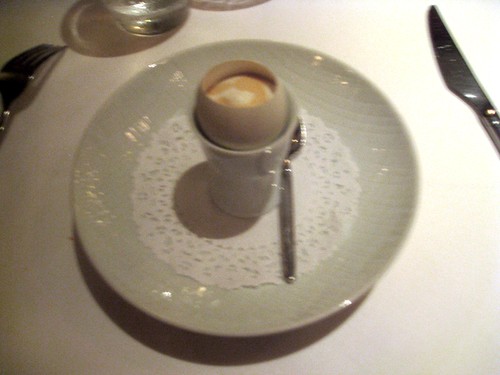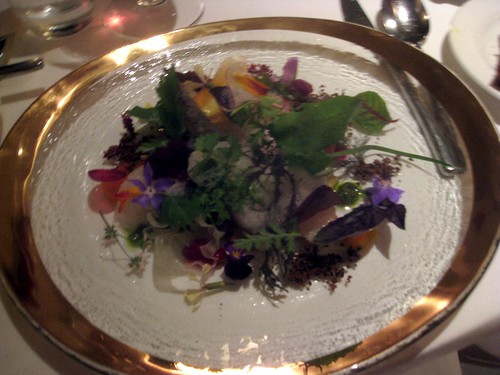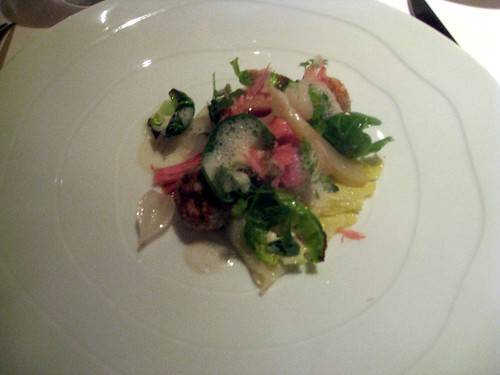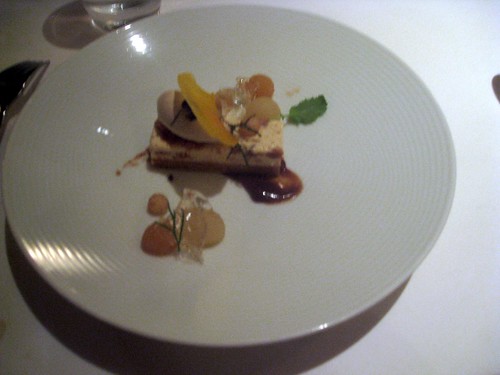Everyone foodie needs a goal in life, if for no other reason than to keep him off the streets. And so during my year in Silicon Valley (Palo Alto, actually), I made a commitment to myself to visit Manresa once a month: for a total of ten visits. Who knows whether, in fact, I will meet my goal, but it surely counts as a caloric packed Jewish New Year’s resolution. Although I have started off slowly (on a month-by-month basis I should be at my third visit), I hope to ramp up soon. I expect to eat through the menu, although I have no doubt that the menu will change to extend my mad dash. (If we were talking about Moto, I could not only eat through the menu, but eat it as well).
It can be debated – endlessly with gustatory gusto – which Bay Area restaurant is the most definitive or the most delicious (not precisely the same question). This is a metropolitan area that sports the French Laundry, Chez Panisse, Gary Danko, and Coi. Countless other restaurants have their own virtues. But there are many partisans for Manresa, David Kinch’s establishment in Los Gatos, which, among its many virtues, includes the avoidance of San Francisco’s traffic.
Of all of the Bay Area’s restaurants, it is Manresa that perhaps owes the most to European (especially Spanish, especially Catalan) cuisine, although Chef David Kinch has the California’s love for all things herbal, vegetative and fructifying.
Manresa as architecture is pleasant, although not startling. The design doesn’t pretend to knock one out, and, in truth, it could house a restaurant deserving one, two, three, or four stars – or perhaps none at all. To say that it is upscale generic is not to suggest that it is corporate. But it lacks the attention to architectural theatrics that one finds at Alinea or Bouley. At Manresa one does not lick the walls, just the plates. The attention is on the food.
Perhaps what I will enjoy most in my essays is finding points to criticize this essential and compelling restaurant. This is the critic’s right and, frankly, his pleasure. This first night – a Sunday – my colleagues and I selected the four course menu. As we moved through the night, I was glad that no one in our party was dieting or that no one was rushed. The dinner became ten courses (some of the extras may have resulted from a friend’s phone call), and spread out longer than four hours. I confess that there will be no objections from this scribe to four amuses (that is a lot of amusement, comparable to Duck Soup or Babette’s Feast), a substantial palate cleanser, and a brief dessert. And it is not the four hours that was at issue. Still, we were surprised at the pacing of the dinner. If four courses last four hours, does David provide PJs for the tasting menu? We were surprised at the gaps between the courses. The amuses were delivered quite expeditiously, but the spaces between the prix fixe courses left much time for conversation. Aside from the pacing, service was very agreeable and we appreciated the wine suggestions of the sommelier: two very food-friendly wines.
My second complaint was an unbalanced dish that I describe subsequently.
I will not spend much time describing the amuses and other extras, but no account of Manresa would be complete without mention of the poached oyster with seaweed and the Arpege egg, an homage to Alain Passard. The former is a marvel of culinary technology, a cooked oyster, designed to taste raw, almost. Chef Kinch was able to capture the fulsome quality of the oceans, particularly the essence of seaweeds that accompanied the dish.

I have not eaten at Arpege – sad moi! – and so I cannot claim any expertise as to whether this yolk compares, but of all of the dishes served it was the most luxuriant and astonishing. The hot-cold soft-boiled egg mixed with cream, maple syrup, and sherry vinegar. The warm egginess is set apart with sour’n’sweet. It is a canonical dish that deserves, like the greatest musical composition to be reprised frequently in culinary concert halls.

For this first meal, I asked our server (Bryan) to suggest the most “typical,” or perhaps archetypical, dishes of the Manresa collection. The dishes were not the ones that I would have ordered from the menu, but I wanted to learn how the restaurant (or at least one of their servers) conceived themselves.
So I began with “Into the Garden . . . Their Natural Juices.” I expected a subtle, restrained dish like Town House’s Vegetable Minestrone. I could not have been further from the mark. Chef Kinch’s salad was a herbal kitchen sink. It had everything that one might imagine, prepared in incredible ways. It looked like an exploded mixed salad, but it tasted like a jazz combo. There were soils, bubbles, foams, leafs, and shoots. If the goal of modern cuisine is the make each bite an experience and to permit interaction with one’s food, this salad succeeded brilliantly.

I promised a criticism, and my second dish is the place. Chef Kinch does not produce laid back cuisine, but why did he have to beat a yuzu drum? I was served butterfish slowly roasted with chanterelles, baby leeks, herbs, and yuzu sabayon. While the butterfish was as buttery and perfectly prepared as advertised, and the chanterelles were welcome, they were overwhelmed by an astringently pushy yuzu sauce. I was astonished by how dominant – how hegemonic – that yuzu was, and I have to wonder whether it was poorly made or deliberately intense. This was sabayon with sharp elbows. I have argued that food need not taste good to be artistic, but this dish seemed something other than serving glass shards to add the taste of blood. After a bite or two I tried to wipe away the sabayon. Perhaps a salmon or mackerel might have stood up to the blows, but not poor little butterfishy.

The third course put the meal back on track: slow roasted rack of veal “tomato,” cabbage with sweet onion and porcini fritter: a Manresa specialty. The label rack of veal was misleading as no rack was in sight. What was served was delicious enough, veal off the bone, cooked as tuna might. Even though this was the main protein course, it had the style of a grand salad, and, with the exception of the amuses mentioned above, the star of the night.

Dessert is prepared in the modern style, mix and match components: Pears and pumpkin cake with Speculaas (spiced cookie) ice cream with moscato jelly, prunes, dates, molasses and pecans. I enjoyed the dish thoroughly although my preference is for a dessert with a central focus: these days pastry chefs feel that rather than creating a single dessert, they create a dozen served on the same plate. Still, it was a successful autumnal sweet.

Chef Kinch deserves those plaudits ladled upon him. Manresa is a four-star restaurant. Yet, after this first meal, I am not quite sure where I would place it in the firmament of dining destinations. The veal “tonnato,” carnivalesque salad, poached oyster, and Arpege egg suggests brilliance. The pacing and yuzu extravagance less so. So with nine meals left, the grade is incomplete.
Manresa
320 Village Lane
Los Gatos, California
408-354-4330
http://www.manresarestaurant.com

1 comment:
I appreciate Manresa's elegant design, but every time I went I was seated with my back to the room.
Maybe it's just me, but being able to see what is going on elsewhere in the space is a key part of the pleasure of fine dining.
Post a Comment